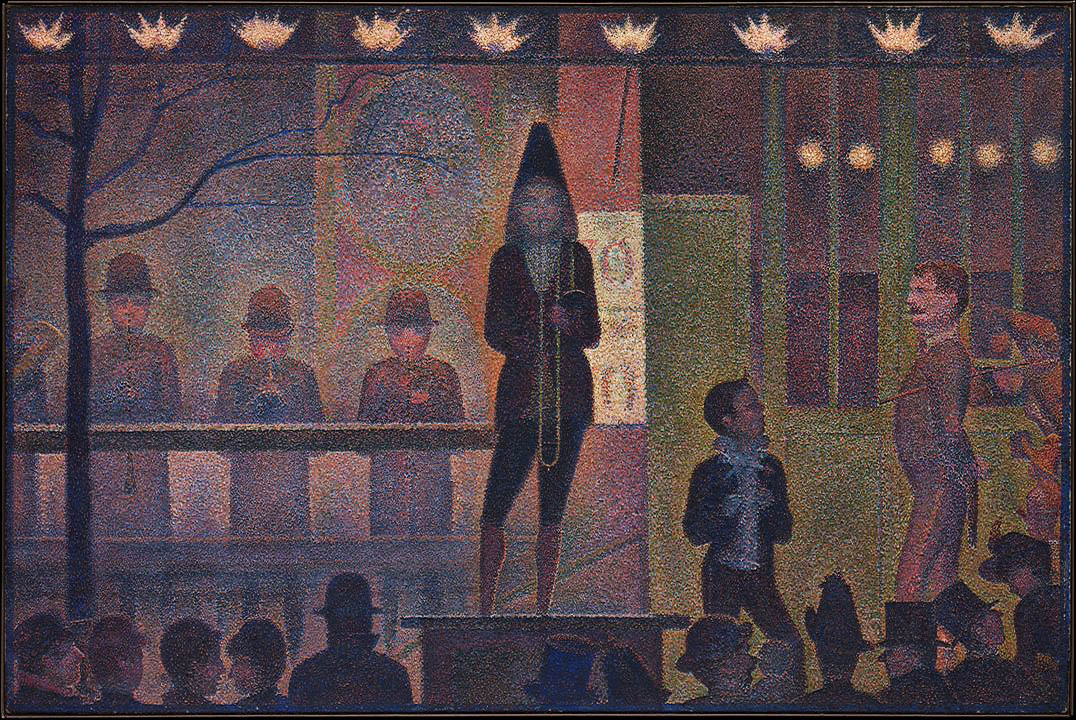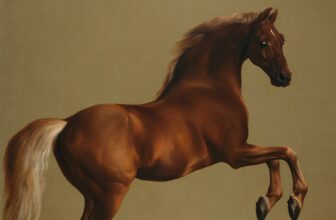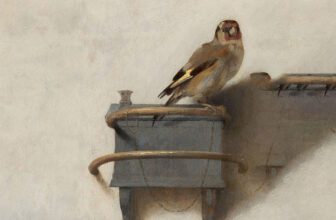
Meaning of Parade de Cirque Painting Georges Pierre Seurat
In the shadowy atmosphere of dusk, beneath the halo of gas lamps, a crowd gathers in subdued silence. On a raised platform, a line of circus performers , static, stoic , advertise the promise of entertainment. Yet the mood is anything but festive. This is the curious paradox of Parade de Cirque (1887–88), a haunting work by Georges Pierre Seurat, the master of Pointillism and one of the most influential figures in the development of modern art.
This lesser-known yet deeply evocative painting invites viewers not merely to observe, but to ponder. It is not a celebration of the circus, but a cool, distant analysis of it. Through composition, color theory, and optical techniques, Seurat transforms a mundane event , a circus parade meant to lure spectators , into a philosophical meditation on modern life, alienation, and the theatricality of existence itself.
Who Was Georges Pierre Seurat?
Before diving into the painting, it’s essential to understand the artist. Georges Pierre Seurat (1859–1891) was a French Post-Impressionist painter who developed Pointillism , a method of painting in small dots or “points” of color that blend in the viewer’s eye rather than on the canvas. He was trained at the École des Beaux-Arts in Paris and initially followed classical techniques, but his artistic vision diverged sharply from academic tradition.
Seurat was fascinated by science and optics, particularly the color theories of Michel-Eugène Chevreul and Ogden Rood. This led to his signature style of Divisionism, also known as Chromoluminarism, which aimed to achieve a shimmering luminosity through precise applications of pure color. His work represented a rational, structured counterpoint to the emotional spontaneity of the Impressionists.
The Creation of Parade de Cirque
Parade de Cirque (translated as Circus Sideshow or simply Circus Parade) was painted between 1887 and 1888 and is one of Seurat’s most enigmatic compositions. The piece is relatively small in scale (39 3/8 × 59 inches or 100 × 149.9 cm), especially when compared to his monumental A Sunday Afternoon on the Island of La Grande Jatte.
Unlike many of his other works which depict leisure and nature, Parade de Cirque is set in an urban environment and takes place at night , a rare choice for Seurat. He prepared the painting meticulously, completing numerous sketches and oil studies, which are now preserved in various museums. The final version was painted in his trademark pointillist technique, a painstaking process requiring incredible precision and planning.
Seurat chose as his subject the entrance to the Cirque Corvi, a small traveling circus that performed in Paris near the Place de la Nation. This wasn’t a glamorous venue; it was a modest, working-class entertainment. By focusing on the parade , a promotional performance held outside the tent to entice passersby , Seurat zeroed in on the boundary between reality and illusion, spectacle and authenticity.
What Is Happening in the Painting?
Under dim streetlamps, four musicians in uniform stand stiffly on a raised platform, playing instruments. Beside them, a ringmaster (or possibly a clown) gestures to a sparse, passive crowd. Behind them, we see the closed curtain of the circus tent. There is no vibrant performance, no glittering acrobats , just the cold ritual of promotion.
The onlookers are reduced to silhouettes. They do not laugh or smile. They do not seem enchanted. Rather than lively engagement, Seurat presents detachment and isolation. The faces are either obscured or expressionless. The painting does not romanticize the circus , it demystifies it.
This atmosphere is enhanced by Seurat’s precise color choices: dark blues, greens, and ochres dominate, creating a twilight gloom. The artificial gaslight casts an eerie pallor on the scene, further emphasizing a sense of distance and unreality.
Symbolism and Meaning in Parade de Cirque
Though it appears mundane on the surface, Parade de Cirque is loaded with symbolic meaning and subtle commentary.
1. Performance as a Metaphor for Life
At the heart of the painting lies a metaphorical question: Is all of life a performance? The entertainers are not entertaining , they are advertising. Their performance is utilitarian, hollowed of joy. Seurat presents them as figures of routine, mechanical in posture and expression. Similarly, the crowd watches not with curiosity, but with resignation. In this reading, Seurat casts a critical eye on modern urban life: structured, impersonal, performative.
2. Alienation in Modern Society
Seurat’s work often grapples with alienation, and Parade de Cirque is no exception. Though a communal event is depicted, there is no sense of community. Figures stand apart, divided by physical space and emotional distance. This aligns with emerging sociological critiques of the late 19th century , particularly those by thinkers like Émile Durkheim and Georg Simmel , who examined how industrialization and urbanization fostered a sense of anonymity and estrangement.
3. Illusion and Reality
Seurat was interested in how visual perception could be manipulated. His use of pointillism itself is a form of controlled illusion , tiny dots creating the semblance of form. This mirrors the theme of illusion in the painting: the parade offers a teaser of magic and joy, but the reality is stiff, lifeless. It’s a performance about performance , a kind of meta-artwork reflecting the hollowness beneath spectacle.
4. Theatricality and Static Composition
Critics often note the painting’s theatrical framing. The platform resembles a stage, and the figures seem like mannequins rather than living people. The curtain behind them is closed , we are denied access to the real show, suggesting either the exclusion of the viewer or the emptiness of the performance itself.
What Type of Art Is Parade de Cirque?
Parade de Cirque is a quintessential example of Post-Impressionism, more specifically within the realm of Neo-Impressionism , the movement Seurat co-founded. It is characterized by:
Pointillism (Divisionism): Applying tiny dots of pure color to allow the viewer’s eye to blend them optically.
Structural Composition: Unlike the spontaneous brushwork of Impressionism, Seurat’s work is carefully calculated and geometrically arranged.
Scientific Color Theory: Seurat’s colors are based on optical science, often appearing muted or darkened in reproductions but radiant in person due to their pointillist interplay.
Symbolic Undertones: Unlike the fleeting impressions of Monet or Renoir, Seurat’s works are layered with deeper philosophical content.
In many ways, Parade de Cirque bridges naturalistic observation with symbolist abstraction, making it a landmark in the transition from 19th-century realism to 20th-century modernism.
Composition and Technical Mastery
Seurat’s composition is both minimal and masterful. The central axis of the image is dominated by a single gas lamp, creating a soft, ghostly glow. The symmetry of the platform and the alignment of figures suggest a mathematical order, consistent with Seurat’s love for classical art and geometry.
The eye is led from left to right, from the figures in profile toward the rear of the stage and the unseen circus behind. This horizontal flow mimics the experience of passing by the scene on the street , as if we, too, are spectators, part of the anonymous crowd.
Every aspect of the painting , color, shape, and line , contributes to a sense of stillness and silence, a paradox in a scene that should be loud and lively.
Where Is Parade de Cirque Located Today?
Today, Parade de Cirque is part of the collection of The Metropolitan Museum of Art in New York City, where it resides as one of the crown jewels of the museum’s 19th-century European collection. It can usually be found in the galleries dedicated to modern European painting, alongside works by van Gogh, Cézanne, and other Post-Impressionist masters.
The Met acquired the painting in 1960 from a private collection, and it has since become an essential piece for understanding Seurat’s legacy. Due to its subtle palette and delicate technique, it’s best experienced in person, where the optical intricacies can be fully appreciated.
Influence
Though not as famous as A Sunday Afternoon on the Island of La Grande Jatte, Parade de Cirque had a profound influence on the development of modern art. Artists like Paul Signac, Henri Matisse, and even early Cubists drew from Seurat’s structural approach and chromatic theories.
The painting’s urban subject matter, cool detachment, and emphasis on ambiguous narrative were also precursors to later movements such as Symbolism, Surrealism, and even Cinema. Its theatrical lighting and flattened perspective anticipate techniques used by filmmakers like Robert Bresson or Carl Theodor Dreyer, who explored similar themes of human isolation and performative identity.
A Revolution
Parade de Cirque may not dazzle at first glance. It lacks the bright colors and vibrant motion we typically associate with circus scenes. But this is precisely its genius. Seurat strips the circus of glamour to reveal the structural, existential underpinnings of modern life. With meticulous technique and philosophical depth, he transforms a fleeting public spectacle into a timeless meditation on appearance versus reality, human estrangement, and the constructed nature of experience.
In an age obsessed with entertainment and image, Parade de Cirque remains hauntingly relevant. It is a painting that doesn’t just depict a scene , it asks questions, invites contemplation, and challenges the viewer to look beyond the surface. In its silence lies its power. And in its stillness, a quiet revolution.
If you’re ever in New York, don’t miss the chance to see Parade de Cirque in person. Stand before it not just as a viewer, but as a participant in its ongoing dialogue , between light and shadow, performance and reality, illusion and truth.




